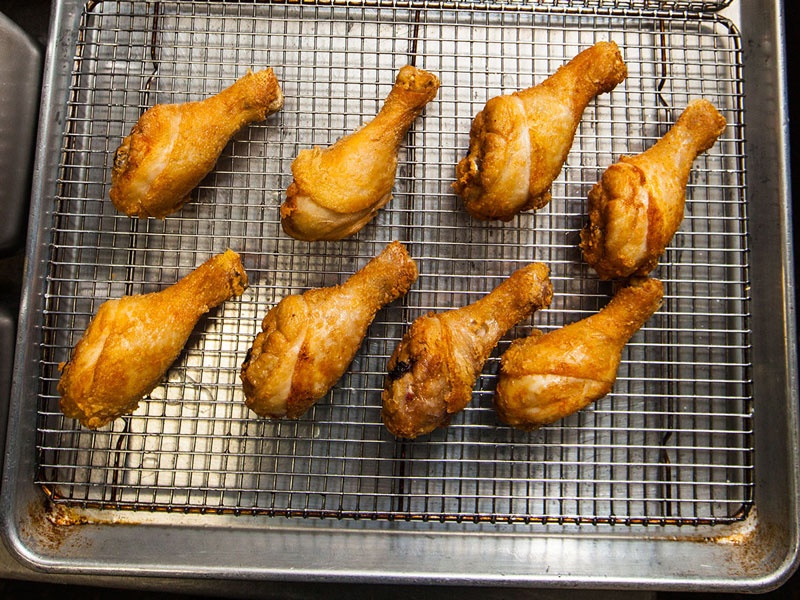From the Farm to the Commercial Kitchen

High oleic: an innovative solution for high-volume bakers and fryers
Many of you know that farmers receive a premium for growing high oleic soybeans. But did you know that is because end users place added value on this product due to its many uses? Do you know what its many uses are?
In a nutshell: Commercial bakers and fryers like high oleic soy because it’s a stable oil with a neutral flavor that performs well under high-heat conditions. Additionally, with the U.S. Food and Drug Administration (FDA) mandate to phase out partially hydrogenated oils by June 2018, many end users are looking for oil replacements without added trans fats.
And while high oleic may never make its way into your home kitchen, the baking industry, restaurants and food companies are discovering it’s the solution they’ve needed:
- High oleic soybean shortenings behave the same way as partially hydrogenated oils (PHOs), creating a smooth transition for bakers
- Longer shelf life, eliminating the need for additives
- Consistent performance
- And, of course, no trans fats.
Before many will make the switch, however, they want to be confident that there will be a supply to meet their demand. The soy industry needs to prove its commitment to its end users and continue increasing high oleic acres.
Baking a simple solution
Baking is equal parts art and science. The art is in the design and presentation of delicious treats, while the science includes complex chemical reactions needed to satisfy taste buds.
With terms like rebaudioside and erythritol being common chemistry vocabulary for bakers, enzyme interesterified (EIE) high oleic soybean oil shortening might just be the simplest mouthful contributing to mouthfuls of baked goods.
High oleic soybean oil is a truly functional solution to replace PHOs.
“As we in the baking industry all know, the FDA has banned PHOs. We’ve got to get them out of all of our foods by June 2018,” says United Soybean Board edible oils expert Frank Flider. “The soy checkoff is working to provide the food industry with U.S.-grown, functional, high-performing solutions.”
Replacing PHOs is a challenge for bakers, who have to go back to the drawing board in many cases to reformulate their recipes. High oleic soybean shortenings, however, work and feel like the PHO shortenings that bakers are used to.
“In terms of stability, functionality and structure, it performs very similarly to what bakers are used to working with,” Flider says.
Icing sculptor Becky Wortman, one of Dessert Professional Magazine’s Top 10 Cake Artists in North America for 2014, chimed in with her experiences using high oleic soybean oil shortening.
“For the sculptures I’ve been doing with other oils for the last three years, I have had problems. If you don’t have them at the right temperature or if you let them sit out, there will be cracking in the frosting,” she says. “High oleic soybean oil shortening is really flexible and lasts a long time. I’ve had sculptures sitting up for about a year.”
Typically, replacement oils act differently and have inferior workability compared to PHOs. Mitch Riavez, a fourth-generation certified master baker with 40 years’ experience in the industry, says interesterified high oleic soybean oil shortenings stand out among PHO replacements.
“High oleic soybean oil shortening is the first true drop-in I’ve encountered,” he says. “It feels the same and it has the same plasticity and feel in the hand. It’s very different than the other replacements I’ve encountered.”
Riavez is the national accounts director for Stratas Foods, a company working with USB through QUALISOY to study the functionality of high oleic soybean oil. Compared to the oils of commodity soybeans and other high oleic oilseed crops, high oleic soy has shown strong performance.
“Here’s what we’ve discovered: High oleic has a longer shelf life, less absorption and lower polymerization,” he says.
High oleic soybean oil and shortenings are available to bakers now, and the soybean industry is ramping up to meet increasing demand by doubling acreage over the next several years. Eventually, about 9.3 billion pounds of oil will be available for use by the food industry.
“To put that in perspective, the PHO volume in its heyday was at about 9 billion pounds,” Flider says. “So we’re going to be able to fully replace all the PHO that’s being taken out of the food system.”
High oleic. A perfect match for fried favorites
High oleic soybean oil is making friends with the chefs who prepare fried foods, and its nutritional profile could earn even more popularity among the people eating them.
High oleic soybean oil offers the same sizzling crunch and clean flavor as commodity soybean oil and other popular frying oils. It also features longer stability and fry life. And its favorable compositional profile means it won’t contribute trans fats.
“It’s important that the ingredients used to produce finished foods have a long shelf life,” says Flider. “With high oleic soybean oil, there is no need for additives to maintain stability, which is great because consumers want clean labels. The fewer the ingredients the better.”
With support from USB, the oil has been rigorously tested. Results of that testing prove it can the shelf life of the products made with it. It also features a favorable flavor profile and leaves food tasting less greasy.
“Its best use is in deep frying; high oleic soybean oil is ideal for any restaurant chain with a deep fryer,” says registered dietician Joy Blakeslee, who conducts high oleic outreach among oil end users on behalf of the checkoff. “They’re finding that the oil performs from the time they put it in the fryer until they take it out. Food is consistently golden brown and the eating experience has been very good.”
Firebirds Wood Fired Grill and The Inn at Virginia Tech participated in case studies conducted by the soy checkoff in which they tested the oil using their own menu items. They found that foods cooked in high oleic oil had a neutral flavor, high moisture content and a reduction of calories.
“We are noticing our chicken fingers fried in high oleic oil are holding less oil and more moisture, which also provides a higher quality of taste,” says Steve Sturm, executive chef at Firebirds.
While food oil users have shown excitement about high oleic, before making the switch to high oleic soybean oil, they need confidence in a reliable supply.
“High oleic soybean oil has the whole package and is going to be the high-stability oil of the future,” Flider says. “As volume and availability grows, use of the oil by fast-food restaurants and processed-food manufacturers will continue to increase with it.



